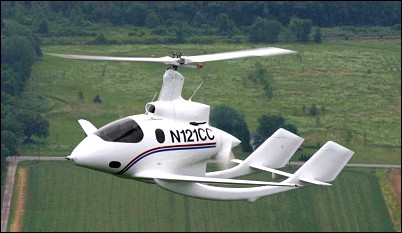
| CarterCopters CC1 1989 |  |
 |

| CarterCopters CC1 1989 |  |
 |
|
The CarterCopters LLC company founded in 1994 by Jay Carter, who previously worked on design of the Bell XV-15 tiltrotor. CarterCopters has produced a flying prototype of what it anticipates will be a family of convcrtiplanes, although its ultimate purpose is to market the design, not establish a manufacturing programme itself. CARTER CARTERCOPTER CC1 TYPE: Convertiplane. PROGRAMME: Developed with US$670,000 funding from NASA, the CarterCopter has been conceived as the first in a series of convertiplanes. First flight (N121CC) September 1998; development delayed following damage to prototype during aborted rolling take-off 16 December 1999; flight testing resumed late October 2000 and was interrupted by minor accidents in April 2001. Attempts are planned on rotary-wing world records. On 22 March 2002, the CCTD reached m=0.87 (relationship between forward speed and blade speed); company hoped to attain m=1 by early 2003 but prototype again damaged in landing accident on 8 April 2003. Following repair, a further m=1 attempt was scheduled for November 2003 but later postponed until the second quarter of 2004.
CURRENT VERSIONS:
CUSTOMERS: Prototype only by end 2001. COSTS: Production versions expected to sell for US$250,000 to US$300,000 (1997; latest data). DESIGN FEATURES: Twin-boom configuration with high-aspect ratio sweptback wings. Pylon-mounted two-blade rotor is powered for take-off and landing, free-rotating in forward flight, when all power is transmitted to a pusher propeller. Maximum prerotation and flight speed 425rpm; minimum in-flight rotor speed 80rpm. FLYING CONTROLS: All-moving elevator; twin rudders. STRUCTURE: Fuselage of seamless moulded composites. Wing sections outboard of tailbooms removable. Tailbooms extend below propeller tips to protect latter in wheels-up landing. Bearingless rotor system. Rotor blades of carbon composites with twistable carbon spar; 29.5kg weights in each blade tip. LANDING GEAR: Retractable tricycle type. Mainwheels retract into tailbooms. POWER PLANT: One Corvette LS1 piston engine, with two turbochargers in series, driving a two-blade carbon composites propeller with twistable carbon spar. Engine power 447kW for short duration; 224kW at high altitude. Total fuel capacity 606 litres, comprising 227 litres in fuselage tank; 189 litres in centre wing (underfuselage) tank; and two 95 litre tanks in wing outboard sections. ACCOMMODATION: Pilot and passenger in front, plus three further passengers on rear bench seat. SYSTEMS: Cabin pressurised; maximum differential 0.69 bar. Jane's All the World's Aircraft, 2004-2005
|